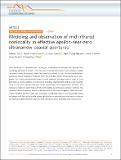Modeling and observation of mid-infrared nonlocality in effective epsilon-near-zero ultranarrow coaxial apertures
Author(s)
Vidal-Codina, Ferran; Nguyen, Ngoc Cuong; Peraire, Jaime
DownloadPublished version (1.950Mb)
Terms of use
Metadata
Show full item recordAbstract
With advances in nanofabrication techniques, extreme-scale nanophotonic devices with critical gap dimensions of just 1-2 nm have been realized. Plasmons in such ultranarrow gaps can exhibit nonlocal response, which was previously shown to limit the field enhancement and cause optical properties to deviate from the local description. Using atomic layer lithography, we create mid-infrared-resonant coaxial apertures with gap sizes as small as 1 nm and observe strong evidence of nonlocality, including spectral shifts and boosted transmittance of the cutoff epsilon-near-zero mode. Experiments are supported by full-wave 3-D nonlocal simulations performed with the hybridizable discontinuous Galerkin method. This numerical method captures atomic-scale variations of the electromagnetic fields while efficiently handling extreme-scale size mismatch. Combining atomic-layer-based fabrication techniques with fast and accurate numerical simulations provides practical routes to design and fabricate highly-efficient large-area mid-infrared sensors, antennas, and metasurfaces.
Date issued
2019-12Department
Massachusetts Institute of Technology. Department of Aeronautics and AstronauticsJournal
Nature Communications
Publisher
Springer Science and Business Media LLC
Citation
Yoo, Daeha et al. “Modeling and observation of mid-infrared nonlocality in effective epsilon-near-zero ultranarrow coaxial apertures.” Nature Communications, vol. 10, 2019, article 4476 © 2019 The Author(s)
Version: Final published version
ISSN
2041-1723